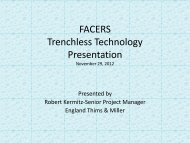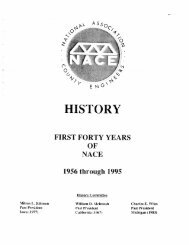Adopting Standard K Factors Throughout FDOT - FACERS
Adopting Standard K Factors Throughout FDOT - FACERS
Adopting Standard K Factors Throughout FDOT - FACERS
You also want an ePaper? Increase the reach of your titles
YUMPU automatically turns print PDFs into web optimized ePapers that Google loves.
movement analyses at points (signalized intersections).Using such an approach providesstatewide consistency at a minimum cost to <strong>FDOT</strong> and outside personnel.Special considerations exist in urban and urbanized areas; both are addressed in the footnotes ofTable 1. In the state’s largest urbanized areas, <strong>FDOT</strong> would designate “core” freeways; major,non-toll freeways going into/through the urbanized core areas (I-4 in the Orlando area). As thesefreeways pass through an urbanized area, the standard K factors range from 8.0% to 9.0%,depending upon proximity to the central core or central business district. <strong>FDOT</strong> district officeswould take the lead on designating factors for the freeways. Final factors would be approved bythe <strong>FDOT</strong> Secretary and FHWA. <strong>Standard</strong> K factors for these freeways would be initially set,not on a project by project basis, and typically updated decennially as part of the urban/urbanizedarea boundary process. Recognizing the desires for future growth in existing developed areas andmultimodal solutions, <strong>FDOT</strong> will also accept and promote lower K factors for non-freeways inwhich transportation infrastructure is adequately addressed. A 7.5% K factor becomes applicablefor state arterials and highways in approved Multimodal Transportation Districts, wheresecondary priority is given to auto vehicle movements. Essentially, this lower factor representsthe promotion of a multi-hour peak period rather than a single peak hour analysis.Implementation of standard K factors on new projects or analyses would become effectiveimmediately upon approval by the Secretary of the Florida Department of Transportation.However, prior actions or approvals could remain in effect. For instance, if during the ProjectDevelopment and Environment phase where location and conceptual design approval has beengranted, the analysis based on a previous K factor could remain in effect throughout projectimplementation.<strong>Standard</strong> K factors should be reevaluated within the initial 3 years of implementation.Pilot Program Implementing <strong>Standard</strong> K <strong>Factors</strong>Before implementing a dramatically different approach for traffic analysis, <strong>FDOT</strong> seniormanagement sought actual testing of the concept. The most significant testing of the standard Kfactor approach was a one-year pilot study by <strong>FDOT</strong> District 4 which implemented standard Kfactors to be used for all traffic analyses in district activities. From 2009 to 2010, twenty-six roadimprovement projects and/or studies were included in the pilot program.Five criteria were used to evaluate the use of standard K factors: K factor comparison (standard K factors compare with K 30 values); Project traffic time comparison (estimated time savings); Project traffic cost comparison (estimated cost savings); Project traffic complexity comparison (qualitative comparison of the two methods); and Comments and feedback regarding use of standard K factors.Conclusions and recommendations from the pilot study follow: Using standard K factors for traffic forecasting at a planning level or ProjectDevelopment and Environment study level is beneficial, as it can reduce the complexityand time needed to develop traffic forecasts;4











